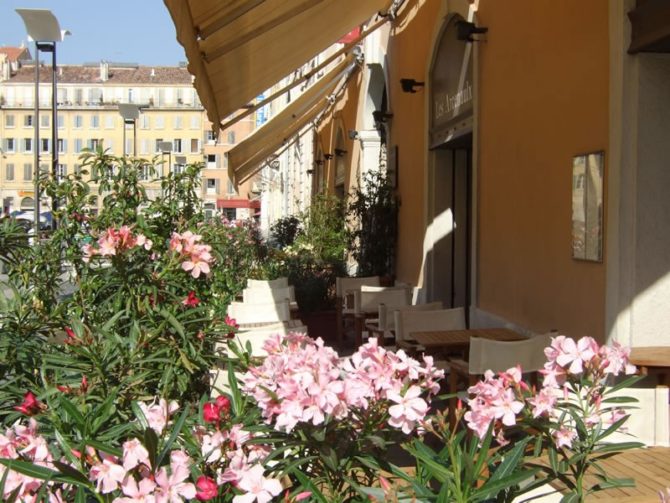In the Ancient Arsenals of Marseille, An Arabian Wellness Fantasy
One of the advantages Marseille offers is that you can satisfy travel yearnings for distant cultures without having to leave the European continent. Like an Oriental carpet spread before your feet, Marseille offers a rich array of exotic worlds. Why not experience a 1001 nights Arabian wellness fantasy – Maghreb-style – in the ancient arsenals?
In the Vieux Port, along the quai Rive Neuve, you’ll find entrances to suspicious-looking alleys (part of Marseille’s “charm”). One of these, No. 16, is the alley you would enter and follow to the very end. (If it is any consolation, there is an Irish pub at the entrance to the alley.) When you can go no further, you will see a children’s clown school and theatre on the right side. On the left is a sign over a door that reads: Zeïn Oriental Spa, your destination. Ring the bell. A hostess will open the door and welcome you into a serene reception room of black, gray and mauve colors with gold accents.
At the reception desk, the attendant will provide you with bath slippers according to your foot size, a thick terry-cloth robe and towel before ushering you through dimly-lit, cavernous passages of the ancient, stone-vaulted caves to a dressing area. After you have changed into your bathing suit you will be guided to a steamy, mosaic-tiled room – the Hammam – where your tensions should melt away as you recline on heated, Moroccan-tiled platforms. As you inhale, healing Eucalyptus-scented steam penetrates deep into your lungs clearing the respiratory tract.
After several minutes here you will move on to a warmer steam room where you relax again on heated banks. Your skin will become soft and supple, ready for the scrub (gommage) which takes place on a pedestal in a different, mosaic-encrusted room. The attendant will slather a traditional, natural soap – resembling tar – all over your skin. This ancient, non-lathering soap, made of potassium hydroxide and olive oil, is called savon noir (black soap) and is exceptionally kind to all skin types and conditions. Savon Noir is one of the three essential parts of the Moroccan Hammam. With a coarse mit called a kessa, the attendant rubs off and hoses away the body’s dead skin and you are left with deeply clean and soft, smooth skin. This is the basic Rituel Ancestral. If you select the Rituel Alhambra you would receive a scented fleur d’orange body mask of Moroccan clay from the Atlas Mountains called Rassoul (to draw out impurities), the second important element of the Hammam, and you would finish off with the third element – a massage with fast-penetrating Argan oil for luxurious, satiny skin.
Now, it is time to wrap yourself up in that thick, terry-cloth robe and recline blissfully on a chaise lounge in a wine-colored Moorish salon while drinking hot tea with fresh mint leaves, and nibbling on dates.
Finally, the time comes to leave this calming oasis. Reluctantly, you pull yourself up, get dressed and make your way through the winding passages to the reception area. Before leaving, you scan the boutique’s selection of precious oils, creams and savon noir.
Whether you are solo, with a companion or a group of friends, the spa offers a programme for everyone, and every budget, with a tempting array of Rituels & Initiations. Each has a tantalizing name such as Rituel Samarcand or Rituel Oasis (un havre de paix à deux). Prices range from 46€ to 136€ and for Hammam rituels à deux from 151€ to 216€. There is even a program for expectant mothers. Of course, a Maghrebian wedding is never complete without the bride and her close friends spending a day at the Hammam in preparation. There are separate days and hours for women, men and couples.
Zeïn Oriental Spa, 16, quai Rive Neuve. Tel: +33 (0)4 91 59 11 11
As you step out into noisy, chaotic Marseille and take a deep breath of the stimulating sea air, you will notice that your appetite has been aroused. A good place to round out your soothing spa-afternoon is to go to another group of arsenals appropriately named, Les Arcenaulx – a place that combines a Provençal tea room, a restaurant, a bookstore, a gallery, and a gift shop – just a short walk from the spa arsenal and one of the most fascinating places in Marseille.
Les Arcenaulx opened its doors as as bookstore/café in 1980 when book editor, Jeanne Lafitte, teamed up with pâtissier, Maurice Mistre who was recreating the recipes of the famous 19th century pâtissier, Antonin Carême, considered the father of haute cuisine. Later on they expanded their services and were joined by oenologist Jean Lenoir, then Simone Lafitte and chef de cuisine, Eric Cornilleau. Open Tue-Sat 12 noon – 11 pm.
Les Arcenaulx, 25 Cours Honoré d’Estienne d’Orves. Tel: +33 (0)4 91 59 80 37
On the other hand, if you want to continue with the Maghrebian theme, walk a little farther to the bazaar area, across from Maison Empereur, and enjoy a delicious, inexpensive meal of couscous at the popular Tunisian tea-room/restaurant, La Goulette. Pick a table outside on the street and soak up the colourful atmosphere, noises and aromas wafting around you. To get there, you simply walk up quai Rive Neuve. The street name will change to Rue Phythéas, then to Rue Vacon. Once you cross Rue de Rome you have reached your destination. La Goulette’s opening hours are continuous from 9 am to 10 pm.
La Goulette Salon de Thé/Restaurant, 1, rue Pavillion. Tel: +33 (0)4 91 33 39 90
The aromatic world of Saladin Épices du Monde, very close to La Goulette, should be your next stop. The Marseillais have been coming here for over 70 years for their special culinary ingredients, spices and myriad other food products from around the world. It became an institution, beginning with an Armenian, Mr. Garibian, who opened the èpicerie. The adjacent business belonged to a Frenchman, Jean Peullet. Thirty years ago both stores were bought out and joined together by the present owner, Saladin El Keurti, an Algerian, who dotes lovingly over his shop. Saladin also carries other household essentials typically used by other cultures. For your home spa you’ll see large tubs of savon noir and chunks of fragrant frankincense and myrrh (to perfume your bathroom or closets). The friendly, helpful staff reflect the caring attitude of the owner. As M. El Keurti says, “C’est merveilleux ici.”
Saladin Épices du Monde, 10, rue Longue des Capucines. Tel: +33 (0)4 91 33 22 76
ABOUT MARSEILLE’S ARSENALS
The arsenals of Marseille comprise an area of the Vieux Port around and behind Quai Rive Neuve, including the Quai des Belges. The structures have gone through many incarnations during their long history.
In the 16th and 17th centuries they served as ship-building docks where slave labour – war captives, criminals, debtors and French protestants unwilling to convert – were chained to their positions 24 hours a day, years on end, working on galleons. They were branded with the letters “GAL.” King Louis XIV, understanding the rebellious nature of the Marseillais, ordered the construction of Fort St. Nicholas as a defensive enclosure against internal revolts.
In the 18th and 19th centuries, as the shipping traffic shifted to the deeper waters of the La Joliette docks, a community of artisans, cabinet-makers, bookbinders and printers replaced the former functions of the old arsenals.
In the second half of the 19th century and early 20th century the area attracted bohemian artists and writers. In the 1960s, after a huge, two-story car park was erected on the Cours Honorè d’Estienne d’Orves, the area fell into decline. The ugly car-park was finally demolished in the 1980s and the Cours went through a period of rehabilitation. Now it looks like a Tuscan piazza. It was Jeanne Lafitte, of Les Arcenaulx, along with a group of architects, who organised the move to restore the Cours.
The Quai des Belges, for its part, became the reserve of fishermen bringing in the catches of the day. The fish market, much smaller now, remains an essential part of life around the Vieux Port.
Dorothy Garabedian is a retired, expat American (born in Rhode Island, raised in central California) living in Germany and now devoting her time to writing on travel, culture and lifestyle. She has traveled around the world and lived in Uruguay and the European cities of Brussels, Paris, Frankfurt, and Moscow. Read more of her work on her blog, Detours and Diversions.
Share to: Facebook Twitter LinkedIn Email
Leave a reply
Your email address will not be published. Required fields are marked *





